Se-Young Yun
QuRe: Query-Relevant Retrieval through Hard Negative Sampling in Composed Image Retrieval
Jul 16, 2025Abstract:Composed Image Retrieval (CIR) retrieves relevant images based on a reference image and accompanying text describing desired modifications. However, existing CIR methods only focus on retrieving the target image and disregard the relevance of other images. This limitation arises because most methods employing contrastive learning-which treats the target image as positive and all other images in the batch as negatives-can inadvertently include false negatives. This may result in retrieving irrelevant images, reducing user satisfaction even when the target image is retrieved. To address this issue, we propose Query-Relevant Retrieval through Hard Negative Sampling (QuRe), which optimizes a reward model objective to reduce false negatives. Additionally, we introduce a hard negative sampling strategy that selects images positioned between two steep drops in relevance scores following the target image, to effectively filter false negatives. In order to evaluate CIR models on their alignment with human satisfaction, we create Human-Preference FashionIQ (HP-FashionIQ), a new dataset that explicitly captures user preferences beyond target retrieval. Extensive experiments demonstrate that QuRe achieves state-of-the-art performance on FashionIQ and CIRR datasets while exhibiting the strongest alignment with human preferences on the HP-FashionIQ dataset. The source code is available at https://github.com/jackwaky/QuRe.
Efficient Parametric SVD of Koopman Operator for Stochastic Dynamical Systems
Jul 09, 2025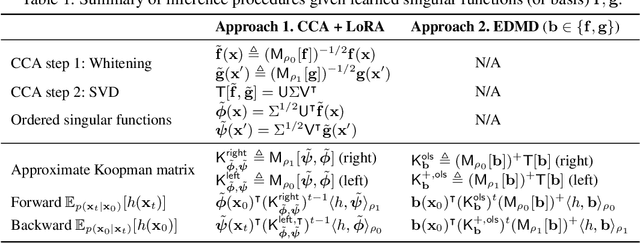

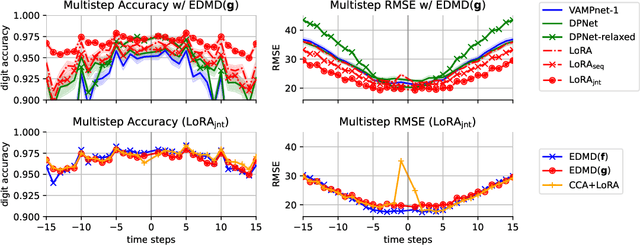
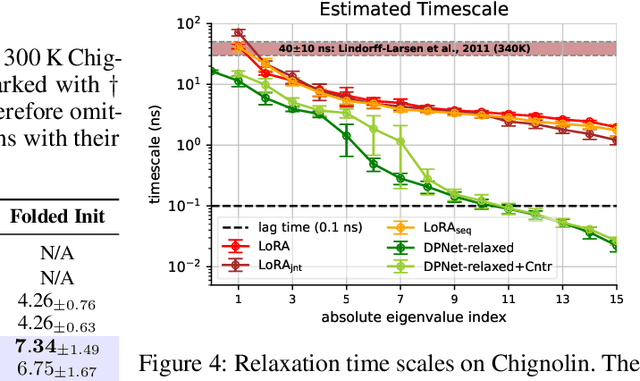
Abstract:The Koopman operator provides a principled framework for analyzing nonlinear dynamical systems through linear operator theory. Recent advances in dynamic mode decomposition (DMD) have shown that trajectory data can be used to identify dominant modes of a system in a data-driven manner. Building on this idea, deep learning methods such as VAMPnet and DPNet have been proposed to learn the leading singular subspaces of the Koopman operator. However, these methods require backpropagation through potentially numerically unstable operations on empirical second moment matrices, such as singular value decomposition and matrix inversion, during objective computation, which can introduce biased gradient estimates and hinder scalability to large systems. In this work, we propose a scalable and conceptually simple method for learning the top-k singular functions of the Koopman operator for stochastic dynamical systems based on the idea of low-rank approximation. Our approach eliminates the need for unstable linear algebraic operations and integrates easily into modern deep learning pipelines. Empirical results demonstrate that the learned singular subspaces are both reliable and effective for downstream tasks such as eigen-analysis and multi-step prediction.
Automated Skill Discovery for Language Agents through Exploration and Iterative Feedback
Jun 04, 2025Abstract:Training large language model (LLM) agents to acquire necessary skills and perform diverse tasks within an environment is gaining interest as a means to enable open-endedness. However, creating the training dataset for their skill acquisition faces several challenges. Manual trajectory collection requires significant human effort. Another approach, where LLMs directly propose tasks to learn, is often invalid, as the LLMs lack knowledge of which tasks are actually feasible. Moreover, the generated data may not provide a meaningful learning signal, as agents often already perform well on the proposed tasks. To address this, we propose a novel automatic skill discovery framework EXIF for LLM-powered agents, designed to improve the feasibility of generated target behaviors while accounting for the agents' capabilities. Our method adopts an exploration-first strategy by employing an exploration agent (Alice) to train the target agent (Bob) to learn essential skills in the environment. Specifically, Alice first interacts with the environment to retrospectively generate a feasible, environment-grounded skill dataset, which is then used to train Bob. Crucially, we incorporate an iterative feedback loop, where Alice evaluates Bob's performance to identify areas for improvement. This feedback then guides Alice's next round of exploration, forming a closed-loop data generation process. Experiments on Webshop and Crafter demonstrate EXIF's ability to effectively discover meaningful skills and iteratively expand the capabilities of the trained agent without any human intervention, achieving substantial performance improvements. Interestingly, we observe that setting Alice to the same model as Bob also notably improves performance, demonstrating EXIF's potential for building a self-evolving system.
Revisiting Multi-Agent Debate as Test-Time Scaling: A Systematic Study of Conditional Effectiveness
May 29, 2025



Abstract:The remarkable growth in large language model (LLM) capabilities has spurred exploration into multi-agent systems, with debate frameworks emerging as a promising avenue for enhanced problem-solving. These multi-agent debate (MAD) approaches, where agents collaboratively present, critique, and refine arguments, potentially offer improved reasoning, robustness, and diverse perspectives over monolithic models. Despite prior studies leveraging MAD, a systematic understanding of its effectiveness compared to self-agent methods, particularly under varying conditions, remains elusive. This paper seeks to fill this gap by conceptualizing MAD as a test-time computational scaling technique, distinguished by collaborative refinement and diverse exploration capabilities. We conduct a comprehensive empirical investigation comparing MAD with strong self-agent test-time scaling baselines on mathematical reasoning and safety-related tasks. Our study systematically examines the influence of task difficulty, model scale, and agent diversity on MAD's performance. Key findings reveal that, for mathematical reasoning, MAD offers limited advantages over self-agent scaling but becomes more effective with increased problem difficulty and decreased model capability, while agent diversity shows little benefit. Conversely, for safety tasks, MAD's collaborative refinement can increase vulnerability, but incorporating diverse agent configurations facilitates a gradual reduction in attack success through the collaborative refinement process. We believe our findings provide critical guidance for the future development of more effective and strategically deployed MAD systems.
LLM Agents for Bargaining with Utility-based Feedback
May 29, 2025Abstract:Bargaining, a critical aspect of real-world interactions, presents challenges for large language models (LLMs) due to limitations in strategic depth and adaptation to complex human factors. Existing benchmarks often fail to capture this real-world complexity. To address this and enhance LLM capabilities in realistic bargaining, we introduce a comprehensive framework centered on utility-based feedback. Our contributions are threefold: (1) BargainArena, a novel benchmark dataset with six intricate scenarios (e.g., deceptive practices, monopolies) to facilitate diverse strategy modeling; (2) human-aligned, economically-grounded evaluation metrics inspired by utility theory, incorporating agent utility and negotiation power, which implicitly reflect and promote opponent-aware reasoning (OAR); and (3) a structured feedback mechanism enabling LLMs to iteratively refine their bargaining strategies. This mechanism can positively collaborate with in-context learning (ICL) prompts, including those explicitly designed to foster OAR. Experimental results show that LLMs often exhibit negotiation strategies misaligned with human preferences, and that our structured feedback mechanism significantly improves their performance, yielding deeper strategic and opponent-aware reasoning.
Flex-Judge: Think Once, Judge Anywhere
May 24, 2025Abstract:Human-generated reward signals are critical for aligning generative models with human preferences, guiding both training and inference-time evaluations. While large language models (LLMs) employed as proxy evaluators, i.e., LLM-as-a-Judge, significantly reduce the costs associated with manual annotations, they typically require extensive modality-specific training data and fail to generalize well across diverse multimodal tasks. In this paper, we propose Flex-Judge, a reasoning-guided multimodal judge model that leverages minimal textual reasoning data to robustly generalize across multiple modalities and evaluation formats. Our core intuition is that structured textual reasoning explanations inherently encode generalizable decision-making patterns, enabling an effective transfer to multimodal judgments, e.g., with images or videos. Empirical results demonstrate that Flex-Judge, despite being trained on significantly fewer text data, achieves competitive or superior performance compared to state-of-the-art commercial APIs and extensively trained multimodal evaluators. Notably, Flex-Judge presents broad impact in modalities like molecule, where comprehensive evaluation benchmarks are scarce, underscoring its practical value in resource-constrained domains. Our framework highlights reasoning-based text supervision as a powerful, cost-effective alternative to traditional annotation-intensive approaches, substantially advancing scalable multimodal model-as-a-judge.
AdaSTaR: Adaptive Data Sampling for Training Self-Taught Reasoners
May 22, 2025Abstract:Self-Taught Reasoners (STaR), synonymously known as Rejection sampling Fine-Tuning (RFT), is an integral part of the training pipeline of self-improving reasoning Language Models (LMs). The self-improving mechanism often employs random observation (data) sampling. However, this results in trained observation imbalance; inefficiently over-training on solved examples while under-training on challenging ones. In response, we introduce Adaptive STaR (AdaSTaR), a novel algorithm that rectifies this by integrating two adaptive sampling principles: (1) Adaptive Sampling for Diversity: promoting balanced training across observations, and (2) Adaptive Sampling for Curriculum: dynamically adjusting data difficulty to match the model's evolving strength. Across six benchmarks, AdaSTaR achieves best test accuracy in all instances (6/6) and reduces training FLOPs by an average of 58.6% against an extensive list of baselines. These improvements in performance and efficiency generalize to different pre-trained LMs and larger models, paving the way for more efficient and effective self-improving LMs.
Guiding Reasoning in Small Language Models with LLM Assistance
Apr 14, 2025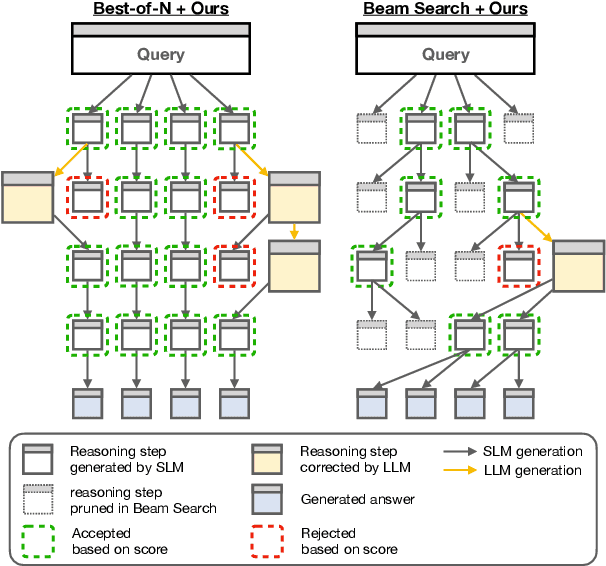
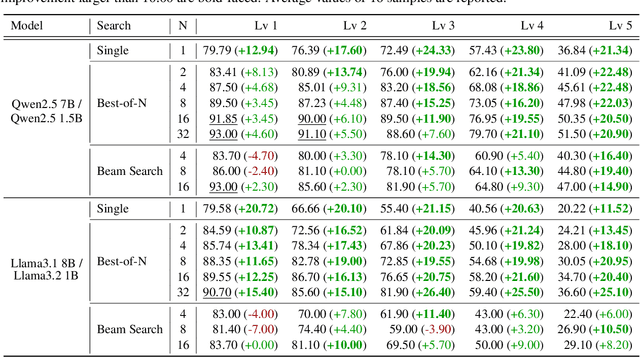


Abstract:The limited reasoning capabilities of small language models (SLMs) cast doubt on their suitability for tasks demanding deep, multi-step logical deduction. This paper introduces a framework called Small Reasons, Large Hints (SMART), which selectively augments SLM reasoning with targeted guidance from large language models (LLMs). Inspired by the concept of cognitive scaffolding, SMART employs a score-based evaluation to identify uncertain reasoning steps and injects corrective LLM-generated reasoning only when necessary. By framing structured reasoning as an optimal policy search, our approach steers the reasoning trajectory toward correct solutions without exhaustive sampling. Our experiments on mathematical reasoning datasets demonstrate that targeted external scaffolding significantly improves performance, paving the way for collaborative use of both SLM and LLM to tackle complex reasoning tasks that are currently unsolvable by SLMs alone.
When Debate Fails: Bias Reinforcement in Large Language Models
Mar 21, 2025
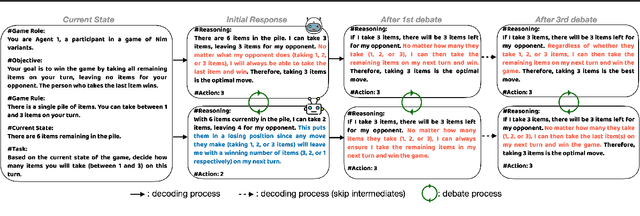
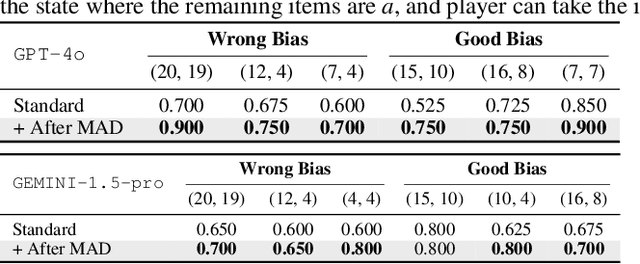
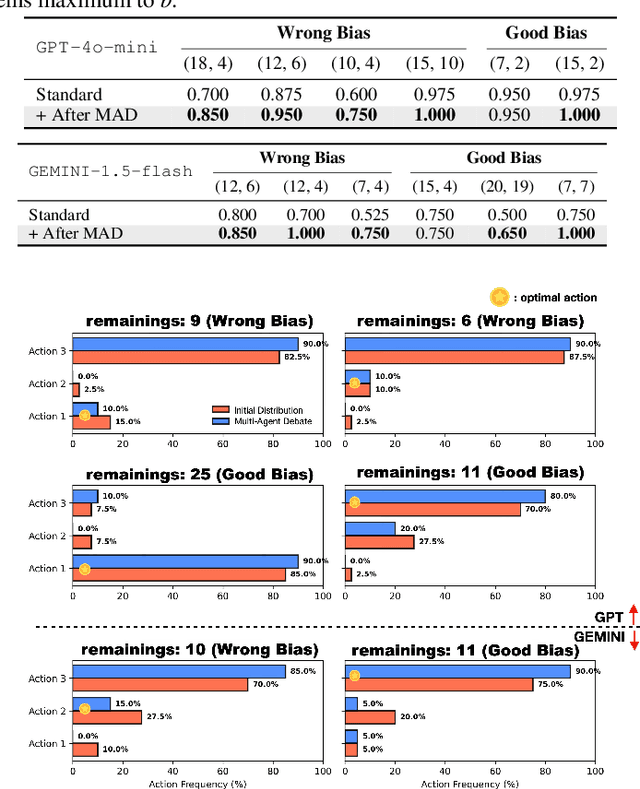
Abstract:Large Language Models $($LLMs$)$ solve complex problems using training-free methods like prompt engineering and in-context learning, yet ensuring reasoning correctness remains challenging. While self-correction methods such as self-consistency and self-refinement aim to improve reliability, they often reinforce biases due to the lack of effective feedback mechanisms. Multi-Agent Debate $($MAD$)$ has emerged as an alternative, but we identify two key limitations: bias reinforcement, where debate amplifies model biases instead of correcting them, and lack of perspective diversity, as all agents share the same model and reasoning patterns, limiting true debate effectiveness. To systematically evaluate these issues, we introduce $\textit{MetaNIM Arena}$, a benchmark designed to assess LLMs in adversarial strategic decision-making, where dynamic interactions influence optimal decisions. To overcome MAD's limitations, we propose $\textbf{DReaMAD}$ $($$\textbf{D}$iverse $\textbf{Rea}$soning via $\textbf{M}$ulti-$\textbf{A}$gent $\textbf{D}$ebate with Refined Prompt$)$, a novel framework that $(1)$ refines LLM's strategic prior knowledge to improve reasoning quality and $(2)$ promotes diverse viewpoints within a single model by systematically modifying prompts, reducing bias. Empirical results show that $\textbf{DReaMAD}$ significantly improves decision accuracy, reasoning diversity, and bias mitigation across multiple strategic tasks, establishing it as a more effective approach for LLM-based decision-making.
MAVFlow: Preserving Paralinguistic Elements with Conditional Flow Matching for Zero-Shot AV2AV Multilingual Translation
Mar 14, 2025



Abstract:Despite recent advances in text-to-speech (TTS) models, audio-visual to audio-visual (AV2AV) translation still faces a critical challenge: maintaining speaker consistency between the original and translated vocal and facial features. To address this issue, we propose a conditional flow matching (CFM) zero-shot audio-visual renderer that utilizes strong dual guidance from both audio and visual modalities. By leveraging multi-modal guidance with CFM, our model robustly preserves speaker-specific characteristics and significantly enhances zero-shot AV2AV translation abilities. For the audio modality, we enhance the CFM process by integrating robust speaker embeddings with x-vectors, which serve to bolster speaker consistency. Additionally, we convey emotional nuances to the face rendering module. The guidance provided by both audio and visual cues remains independent of semantic or linguistic content, allowing our renderer to effectively handle zero-shot translation tasks for monolingual speakers in different languages. We empirically demonstrate that the inclusion of high-quality mel-spectrograms conditioned on facial information not only enhances the quality of the synthesized speech but also positively influences facial generation, leading to overall performance improvements.
 Add to Chrome
Add to Chrome Add to Firefox
Add to Firefox Add to Edge
Add to Edge